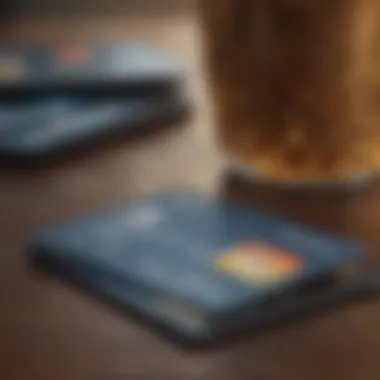Understanding Credit Card Arrival Timelines


Intro
Navigating the world of credit cards can be overwhelming for many. Applying for one is often the first step to managing personal finance effectively. However, a common concern among applicants is understanding how long it takes for their credit card to arrive. Knowing this information is essential as it can influence financial planning and immediate spending needs. This article aims to illuminate the process, detailing timelines, factors that affect delivery, and how to prepare while waiting.
Overview of Financial Product
Definition
A credit card is a financial tool that allows individuals to borrow funds from a predefined limit to make purchases. It provides a convenient means for handling expenses without the need for immediate cash.
Key Features
Credit cards come with several features that can benefit users. These include:
- Credit Limit: The maximum amount one can charge to the card.
- Grace Period: A period where no interest accrues if the balance is paid in full by the due date.
- Rewards Programs: Many cards offer points or cashback for purchases.
- Contactless Payments: Allows for quick transactions with compatible terminals.
Purpose and Benefits
The primary purpose of a credit card is to facilitate transactions. Its benefits include improved cash flow management, the ability to make large purchases, and potential rewards that can yield savings over time. Moreover, responsible use of credit cards can help build a positive credit history.
Types and Categories
Credit Card Types
There is a variety of credit cards available on the market. Some common types include:
- Standard Credit Cards: Basic cards with typical features and limits.
- Rewards Credit Cards: Offer incentives like points for travel or cash back.
- Secured Credit Cards: Designed for individuals with poor credit, requiring a deposit as collateral.
- Student Credit Cards: Tailored for students who may be new to credit.
Pros and Cons
Each credit card type has its own advantages and drawbacks. For example, rewards cards can be beneficial for frequent travelers but may carry higher fees. On the other hand, secured cards can assist in rebuilding credit but might not offer much flexibility or rewards.
Situational Uses
Understanding the situation can help in choosing the right credit card. For example, students may benefit from student cards while young professionals might find rewards cards suitable for their lifestyle and spending habits.
Application Process
Applying for a credit card is a structured process that involves several steps. Knowing these can help streamline your experience.
Steps to Apply
- Research different credit card options.
- Check your credit score to understand your eligibility.
- Fill out the application either online or via paper form.
- Submit any required documentation.
Eligibility Requirements
Credit card issuers generally require applicants to meet specific criteria, such as age, income level, and credit history.
Documentation Needed
Common documentation may include:
- Proof of identity (e.g., driver’s license or passport)
- Verification of income (e.g., pay stub or tax return)
- Social Security number
Common Mistakes to Avoid
Many applicants overlook details that can delay their application. These include:
- Failing to check credit score before applying.
- Not reading the terms and conditions thoroughly.
- Applying for multiple cards simultaneously, which can negatively impact credit score.
Tips for Success
To increase the chances of approval, ensure all information is accurate. Avoid applying for cards that do not suit your financial situation.


Costs and Fees
Understanding the costs and fees associated with credit cards is vital.
Types of Fees Associated
Common fees may include:
- Annual Fees: Charged yearly for card benefits.
- Late Payment Fees: Imposed for missed payments.
- Foreign Transaction Fees: Charged for purchases made in other currencies.
Interest Rates and APR for Loans/Cards
Interest rates vary widely among credit cards. Knowing the Annual Percentage Rate (APR) is crucial as it determines how much interest you will pay on outstanding balances.
Prelude to Credit Card Arrival Times
Importance of Understanding Delivery Times
There are several reasons why grasping delivery times for credit cards is significant. First, applicants can better plan their financial activities. Knowing when to expect a card can help avoid situations where a credit line is needed urgently. Being informed also enhances the user experience by reducing uncertainty. Additionally, understanding the nuances of card delivery can guide applicants in choosing providers that align with their needs and expectations.
General Expectations for Credit Card Arrival
Generally, credit cards take between seven to ten business days to arrive after approval. However, individual experiences can vary based on a multitude of factors. For example, people living in urban areas may receive their cards faster compared to those in remote locations. Furthermore, the type of card applied for can influence delivery times. Special promotional offers or limited edition cards may also introduce delays. Recognizing these variables is crucial for setting realistic expectations as you wait for your new credit card.
Standard Timelines for Credit Card Delivery
Understanding the standard timelines for credit card delivery is crucial for anyone who has applied for a card. Knowing what to expect can ease anxiety and allow for better financial planning. When a person submits an application, they generally have a rough idea of how long it might take to receive their credit card. This period typically ranges from a few days to several weeks, depending on several specific factors. Understanding these timelines can help users navigate their expectations and responsibilities effectively.
Typical Timeframes to Expect
When applying for a credit card, one should anticipate a general timeframe for delivery. Typically, applicants can expect their card to arrive within 7 to 14 business days after approval. However, this is just an estimate. Many factors, such as the issuer's processing time and shipping method, can affect actual delivery. If the application was submitted via a digital platform or in person, the timing may differ slightly.
It is essential to monitor the application status through the issuer’s platform, as updates can provide more clarity. Sometimes, unexpected delays can arise, and being informed can help mitigate frustration.
Comparison of Different Card Types
Different types of credit cards can have varying timelines for delivery based on their characteristics and approval processes. Understanding these distinctions is key for potential cardholders.
Standard Credit Cards
Standard credit cards usually have a straightforward delivery timeline. These cards are commonly issued to individuals with established credit histories. Once the application is approved, customers often receive their cards within 7 to 10 business days. The key characteristic that makes standard credit cards popular is their accessibility for individuals with good or average credit scores. The simplicity of their approval process contributes to their appeal. Many applicants appreciate how quickly they can gain access to credit without extensive requirements.
Rewards Cards
Rewards cards tend to be more appealing for those who wish to gain benefits from their spending. However, they often require a higher credit score, which can lead to more intricate approval processes. Once approved, though, they can take about 10 to 14 business days to arrive. The unique feature of rewards cards is their potential for earning cashback or points. This benefit makes them a popular choice among individuals who spend often and want to maximize their returns. However, users should be cautious, as the annual fees associated with some rewards cards can outweigh the benefits if not managed properly.
Secured Credit Cards
Secured credit cards are designed for individuals looking to build or rebuild their credit profiles. These cards require a cash deposit as collateral, which serves as the credit limit. This security feature allows for a more accessible approval process, even for those with poor credit histories. The timeline for delivery is often similar to standard cards, typically around 7 to 14 business days after approval. The advantages of secured credit cards include the ability to improve credit scores over time. However, they may have limitations in terms of available credit and few rewards, making them less advantageous for some users.
The End
In summary, the understanding of standard timelines for credit card delivery is essential for users navigating their new financial tools. Each card type has its particularities, and knowing what to expect can help manage anxiety during the waiting period. Being informed about these timelines assists individuals in making better decisions about credit usage.
Factors Influencing Credit Card Delivery Times
Understanding what affects the timing of credit card delivery is vital for applicants. This knowledge aids in planning and reassures applicants during the waiting period. Many elements contribute to this timeline, including the application approval process, card issuer practices, geographical factors, and seasonal trends. Each of these elements can significantly influence delivery efficiency and affect customer expectations.
Application Approval Process
The application approval process is a critical factor that can delay the delivery of a credit card. Once a person applies, the issuer reviews the application. This review includes background checks and assessment of the applicant's creditworthiness. Typically, faster approvals lead to quicker card delivery. If an application is incomplete or requires additional checks, this can cause delays in the overall timeline.
Card Issuer Factors


Operating Procedures
Operating procedures of the card issuer play a significant role in how quickly a credit card gets delivered. Every issuer has their own distinct processes. Some issuers streamline their credit card application and delivery systems, resulting in faster deliveries. Others may have more bureaucratic systems that prolong the fulfillment time. For example, an issuer that automates approval and printing processes tends to deliver cards more quickly.
Logistics and Shipping
Logistics and shipping also significantly affect a card's delivery timeline. Different issuers partner with specific shipping services, which can result in varying speeds of delivery. The methods of shipping they choose, such as standard mail versus expedited shipping, can make a significant difference. Moreover, whether an issuer has a shipping center close to the customer can also impact delivery times.
Geographical Considerations
Geographic location is another important factor in the timeline for receiving a credit card. Some areas may have reliable, timely postal services, while others might experience delays due to local conditions. Urban areas generally receive mail more efficiently compared to rural locations. This variation can make a difference in how quickly an applicant sees their new card after approval.
Time of Year Impact
Seasonal trends also play a significant role in credit card delivery.
Holiday Seasons
During holiday seasons, card issuers often see an increase in applications. This surge can lead to processing slower than average due to the increased workload. Moreover, shipping services might be overburdened, leading to further delays. Understanding these patterns can assist applicants in anticipating longer wait times.
Promotional Periods
Promotional periods can also impact delivery timelines, as many issuers attract more applications with special offers. This influx can stretch approval times and subsequently delay card deliveries. Applicants should consider these promotional periods when they apply if they hope to receive their cards quickly.
The interplay of these various factors means that applicants must navigate multiple elements when awaiting their credit cards. Being aware of them can foster patience and understanding during this potentially anxious waiting period.
Expediting Your Credit Card Delivery
Understanding how to hasten the delivery of your credit card is crucial. Timely access to a credit card can play a vital role in managing expenses, especially for young professionals, families, or students who may need it for urgent purchases. This section examines various elements that can help improve the speed of your credit card’s arrival. The benefits of expedited delivery not only enhance convenience but also contribute to financial management and planning.
Choosing the Right Issuer
Selecting a credit card issuer with efficient delivery processes can significantly impact how quickly you receive your card. Issuers differentiate themselves through varying shipping options and timelines. Some companies offer express or priority shipping, which may come with additional fees but provide quicker access. The issuer's reputation for customer service also matters; research user reviews to determine how well an issuer communicates about delivery timelines. A good choice is to ensure that the issuer provides clear information about their shipping methods and expected arrival times.
Electronic Delivery Options
Many issuers now provide the option to receive a virtual credit card number immediately after approval. This allows you to start making online purchases right away without waiting for the physical card to arrive. Thus, electronic delivery options can serve as a bridge for users eager to utilize their credit before the physical card reaches them.
Benefits of electronic delivery include:
- Instant access to funds for online shopping.
- Enhanced security features often aligned with technological delivery methods.
- Avoidance of waiting periods on shipping times.
However, keep in mind that with electronic options, certain functionalities—like withdrawing cash from ATMs—might not be available until the physical card is received.
Following Up with Your Issuer
If the expected delivery time has passed, do not hesitate to follow up with your card issuer. A simple inquiry through customer service can provide clarity. They may give updates on your card’s status and any potential issues that may have arisen.
When following up, it’s helpful to:
- Have your application details ready—this includes any reference numbers or your Social Security number.
- Ask specific questions about shipping methods, expected timelines, and if delays are common at that time.
Effective communication can lead to insights on how to navigate delays and expedite your experience.
Customers should certainly advocate for themselves. A follow-up can sometimes lead to unexpected solutions.
This proactive approach not only provides reassurance but also helps you maintain control of your credit card status.
What to Do While Waiting for Your Credit Card
While awaiting the arrival of your credit card, it is crucial to take proactive steps to ensure you are prepared for its use. This waiting period can often cause uncertainty, but it also provides an excellent opportunity for you to understand better how to use credit responsibly and maximize your financial potential.
Understanding Your Application Status


It is important to stay informed about the status of your credit card application. Most issuers provide a way for you to check your application status online. This may involve logging into your account or contacting customer service directly.
Regularly checking the status can give you peace of mind and help you anticipate when your card might arrive. Knowing whether your application is approved, pending, or rejected allows you to plan your financial activities accordingly.
Preparing for Responsible Use
Setting a Budget
Establishing a budget before your card arrives is an important step. This offers you a clear outline of your spending and helps prevent future financial strain. A well-defined budget enables you to monitor your expenses, ensuring that you spend only what you can afford.
Setting a budget helps you understand your income and expenses. This is a beneficial choice because it promotes financial discipline. You should consider your recurring expenses, savings goals, and discretionary spending when developing your budget. One unique feature of budgeting is that it allows for flexibility, enabling you to adjust your expenses based on your financial reality. Additionally, budgeting can prevent you from exceeding your credit limit, thus avoiding potential penalties.
Learning About Payment Timelines
Familiarizing yourself with payment timelines is essential for responsible credit card use. Understanding when payments are due can help you manage your finances and cultivate good credit habits. This includes knowing when statements are generated and the date by which you must make payments to avoid penalties.
Learning about payment timelines can be beneficial since it enhances financial awareness. When you know the deadlines, you are less likely to miss payments. Each issuer may have different timelines, and being informed can save you money in late fees and interest rates. One advantage is setting reminders for yourself to ensure payments are made promptly, providing a sense of control over your finances.
Troubleshooting Delays
If you encounter unexpected delays in your credit card arrival, consider initiating a conversation with your issuer. Start by confirming that your application is approved and that the card has been sent out. If you experience delivery issues, contacting customer support can help clarify the situation.
Additionally, you may want to double-check your mailing address and verify that it aligns with what your issuer has on file. Sometimes small errors can interfere with timely delivery. Be persistent yet polite in your inquiries, as good communication can expedite the process.
After Receiving Your Credit Card
Understanding what happens after receiving your credit card is crucial in managing your finances. This juncture serves as a bridge between the application process and responsible credit usage. Being well-informed about this phase can help avoid mistakes and enhances your financial literacy.
Activation Requirements
Activation of your credit card is a vital first step. Most issuers require you to activate your card before usage. This process often involves calling a dedicated number or using an online portal. Failure to activate can lead to inconvenience when you attempt to make a purchase.
The primary reason for activation is security. It ensures that the cardholder is indeed the owner of the card. After you complete the activation, your card will be ready for use immediately. The simplicity of this process is one key characteristic that makes it popular.
Key Point: Ensure activation is done as soon as the card arrives to start enjoying its benefits.
Initial Usage Considerations
Understanding the specific elements that accompany initial usage is important for new cardholders. Knowing how much you can spend and how to manage that amount sets a foundation for good credit habits.
Credit Limit Understanding
When you receive your credit card, understanding your credit limit is essential. Your credit limit defines the maximum amount you can borrow. Exceeding this limit can lead to fees and a negative impact on your credit score. This aspect is important for responsible spending as it encourages you to live within your means.
The benefit of a clearly defined credit limit is that it promotes disciplined financial behavior. You will also be more aware of your spending habits and how they affect your overall financial health.
Awaiting Physical Card vs.
Virtual Card
Many card issuers now offer virtual cards that can be used before the physical card arrives. This feature allows users to make online transactions immediately. Virtual cards have a unique characteristic of offering instant access while waiting for the physical card to arrive. This can be beneficial for urgent purchases.
However, there are drawbacks. Virtual cards may not be suitable for in-person transactions or may have less security than a physical card. Understanding these pros and cons allows users to make informed decisions based on their immediate financial needs.
Carefully considering your strategy for activating your card and understanding its features helps in navigating the world of credit confidently.
Epilogue
Recap of Key Points
The major points covered in this article include:
- Standard timelines for different types of cards such as standard credit cards, rewards cards, and secured credit cards.
- Factors influencing delivery times like application approval, issuer procedures, geographical considerations, and seasonal impacts.
- Strategies for expediting credit card delivery, including the choice of issuer, electronic delivery options, and follow-up practices.
- Options to consider while waiting for your card, such as monitoring application status and preparing financially for new card usage.
- Important aspects related to activation and initial usage once the card arrives.
Encouragement for Informed Decisions
Being well-informed plays a significant role in effective credit card management. With the insights shared in this article, individuals are encouraged to be proactive and make informed decisions regarding credit card applications. The knowledge about timelines and influencing factors enables more strategic planning, thus maximizing the benefits of credit cards while minimizing frustrations of unexpected delays.
Informed consumers significantly enhance their financial stability by understanding the processes involved in credit card acquisition.



